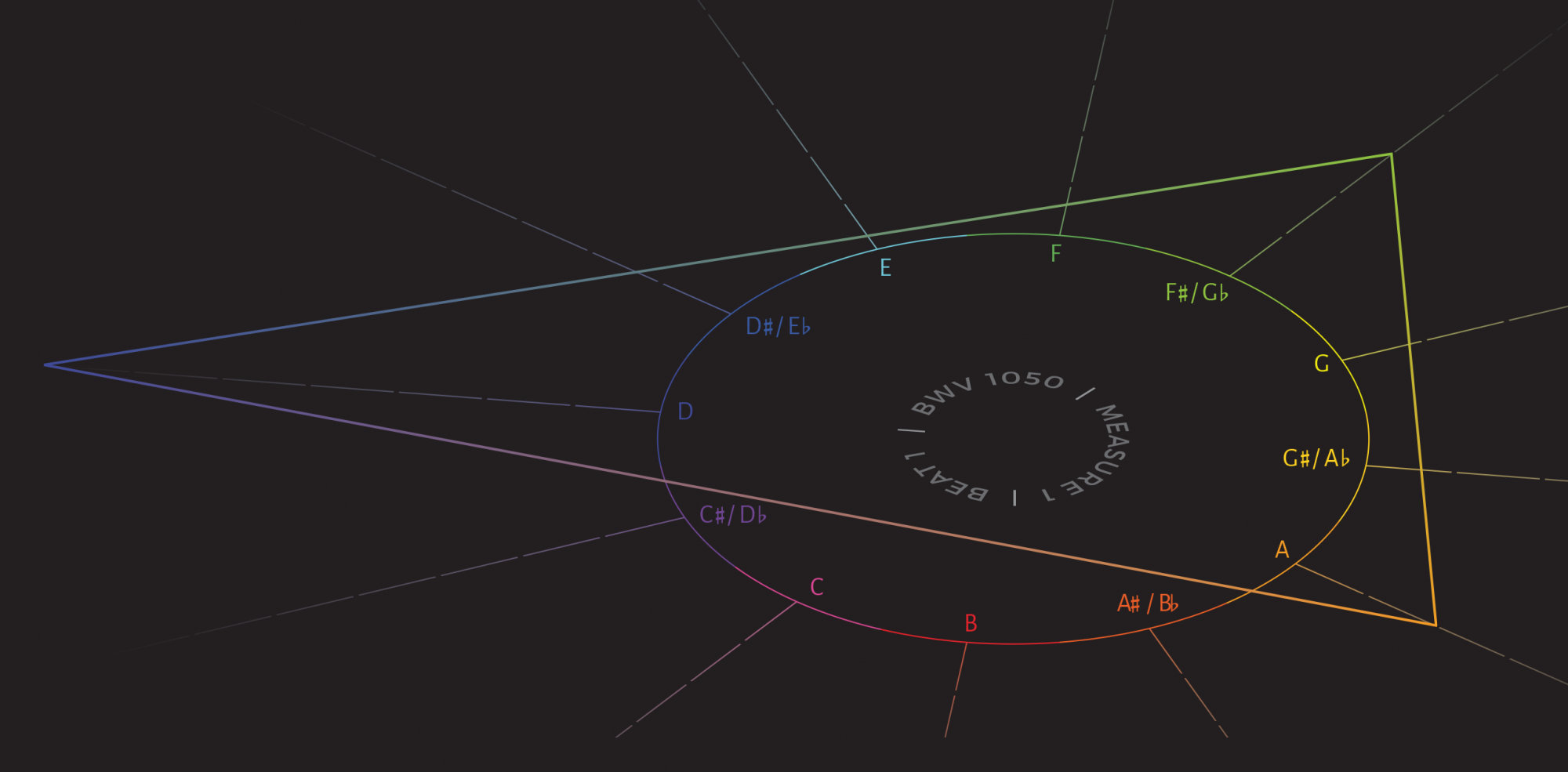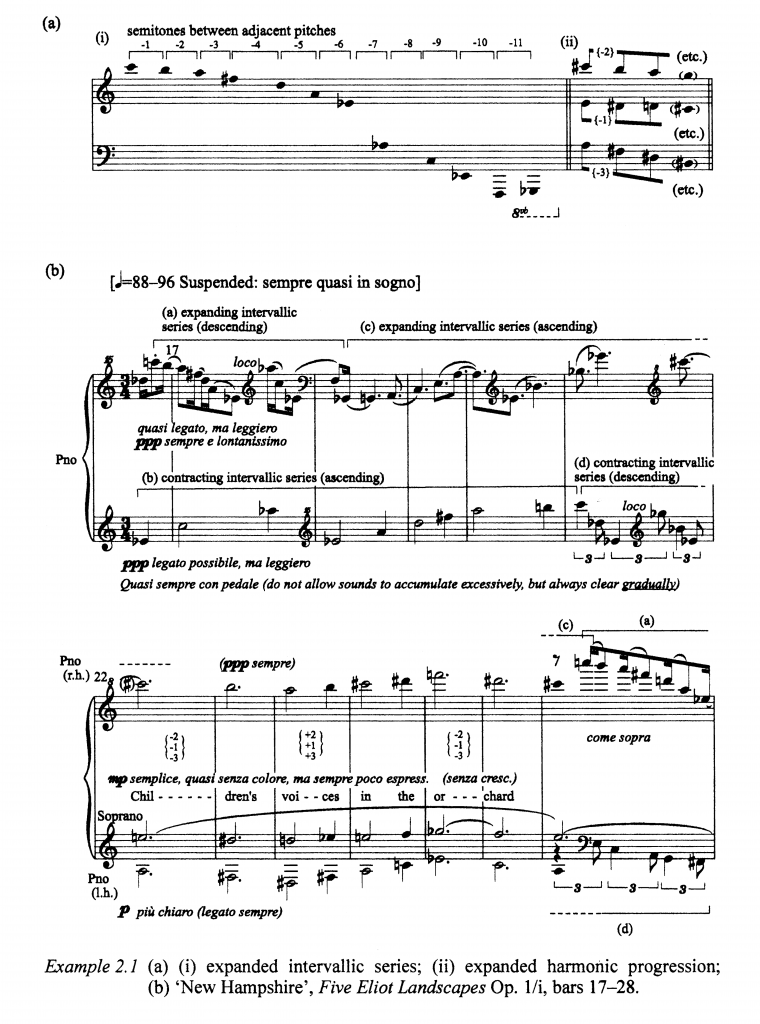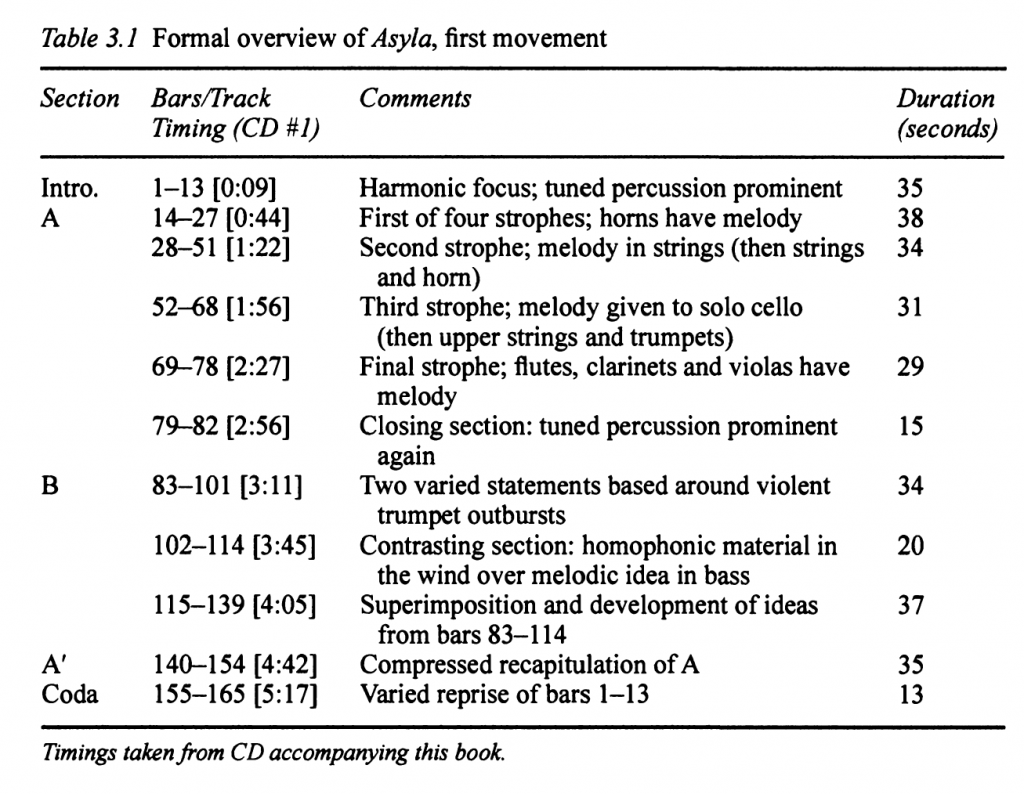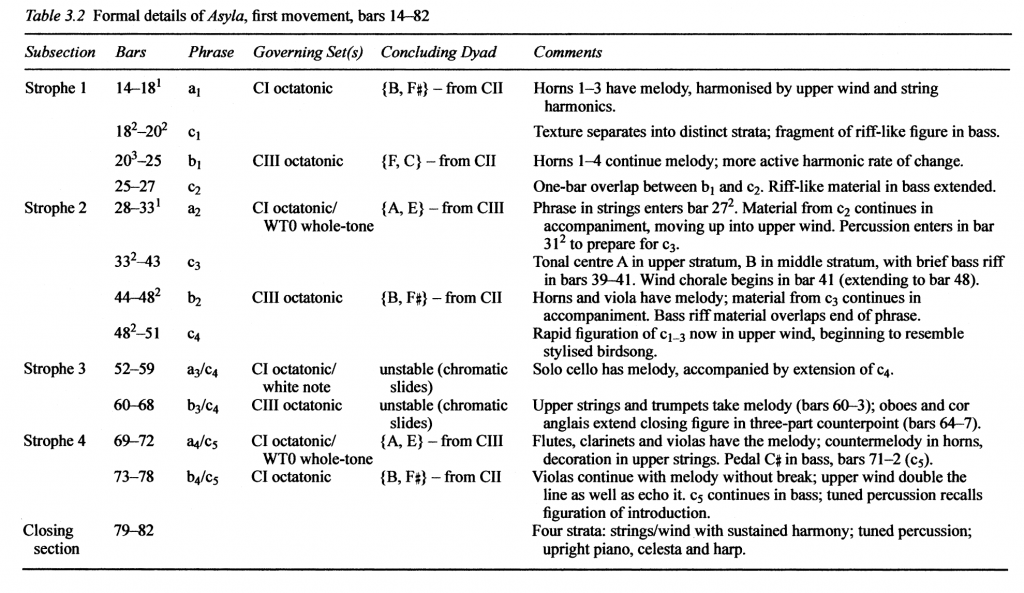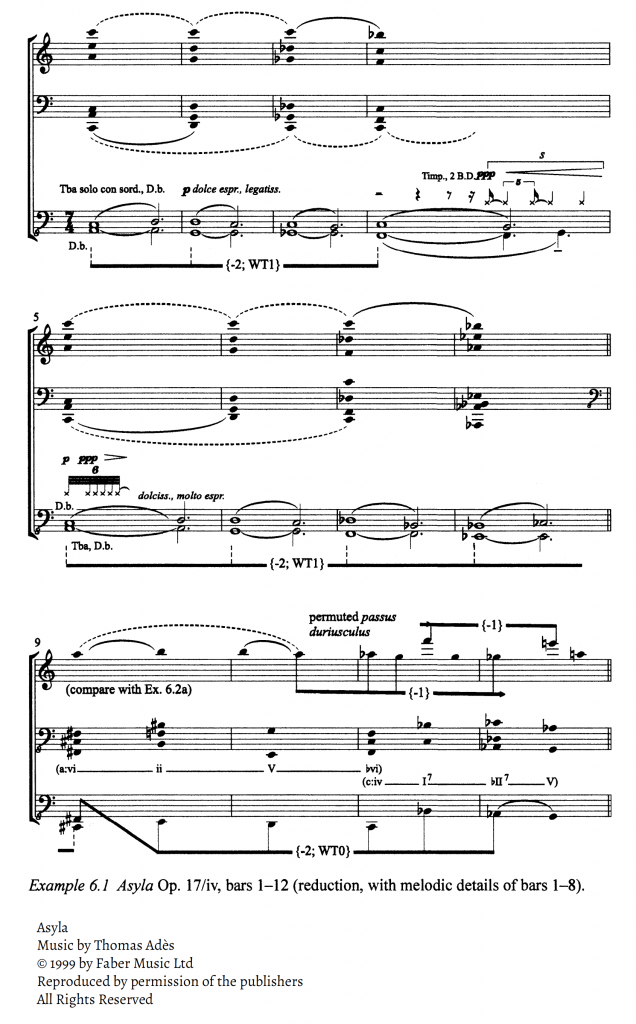Philip Stoecker
View PDF
The life and works of British composer Thomas Adès (b. 1971) have recently garnered much critical attention. Since the early 2000s, the number of scholarly articles and dissertations about Adès’s compositions and his compositional procedures has steadily increased and shows no signs of slowing down.1 The first book published about Adès’s music was written in French by Hélène Cao (2007). The next book to appear was created by Adès himself in collaboration with music critic Tom Service. Together, Adès and Service (2012) published their conversations as Thomas Adès: Full of Noises.2 Edward Venn’s Thomas Adès: Asyla, published in 2017 by Routledge as part of their “Landmarks in Music Since 1950” series,3 adds to this short list of booklength studies that focus on the music of Adès. This pioneering text has laid a significant foundation for future Adès studies. Venn, who has published numerous insightful analyses (2006, 2014, 2015) on Adès’s music, explains the goal of his monograph:
The account of Asyla offered in this book is by definition my personal response to a work that I have listened to, studied and enjoyed for nearly two decades. I offer a close analytical reading of the score, along with theoretical reflection (both musicological and critical) upon this analysis. By carefully laying out the grounds for my argument, I hope to demonstrate (without overloading the text with theoretical jargon) why the music moves me in the way it does, whilst enabling readers to reach their own alternative interpretive conclusions: the semantic richness of Asyla makes the notion of a single, definitive reading nonsensical. (xv)
Thomas Adès: Asyla is symmetrically organized so that the outer chapters (Chapters 1, 2, 7, and the Epilogue) are biographical in nature and position Asyla (1997) not only within the composer’s compositional output, but also in a broader cultural context, while the four central chapters (Chapters 3–6) provide in-depth analyses of all four movements of the work. Attached to the inside of the back cover is a CD recording of Asyla performed by the City of Birmingham Symphony Orchestra, conducted by Sir Simon Rattle; until recently this was the only commercially available recording of Asyla.4 Venn provides the usual bibliographical references, and he also includes additional citations that are helpful for future research. For example, Venn lists two websites where readers can learn more about Adès’s compositions and recordings as well as the web address to Faber Music, Adès’s publisher, to view scores online for study purposes. Venn also provides a discography, lists two radio broadcasts that he discusses in the text, and includes a list of websites that the reader can visit for additional information.
“The first two chapters of the book,” Venn notes, “contextualise Adès and his music” (xvi). In Chapter 1, Venn reviews Adès’s early compositions and his public and critical reception in the 1990s, a decade when Adès was first being recognized for his talents as both performer and composer. In the second half of the first chapter, Venn focuses on “Adès’s early career in the context of Britain in the 1990s” (6). Venn provides a brief survey of the political climate in Britain as it relates to Adès’s social and political situation. In Chapter 2, appropriately titled “Towards Asyla (1990–1997),” Venn describes some of the key compositional techniques that continually surface when analyzing Adès’s music. For instance, Venn discusses an “expanding (or contracting) intervallic series” where successive intervals between pitches increase or decrease usually by semitones, e.g., a C–B–A–
In his discussion of pitch, Venn then explores how “[p]attern disruption frequently assumes a significant role in Adès’s music” (19). For example, he discusses how the vocal line in mm. 396–401 of Adès’s first opera, Powder Her Face (1995), unfolds an expanding intervallic series: E4–F4–G4–B$$\flat$$4–D5–G$$\sharp$$5. Venn points out that, according to the intervallic pattern of this melodic line, G5—and not G$$\sharp$$5—should follow D5. Venn writes, “Here, the deviation from expectation has, amongst other things, a dramatic function. Despite the Duchess’s mounting excitement and hopes of a future of unimagined wealth, the G$$\sharp$$ points to the fact that something is wrong. It might even be understood as standing for what we . . . know is going to happen: her eventual divorce and disgrace” (19). Other topics in this chapter include Adès’s use of rhythm (mensuration canons and intricate rhythmic patterns), sonority (extreme pitch registers), genre, external references, and metaphor. From here, Venn discusses the compositional background of Asyla and reviews some of the early debates surrounding the symphonic logic of the piece.
In Chapter 7, “Interpreting Asyla,” Venn discusses the reception of the work from the public and the press, and he also reviews the “critical analysis of the work” (xvi). As Venn argues,
[t]he purpose of this chapter is to extend my interpretation of Asyla to take into account the broader discursive practices in which it is situated, and its active participation in meaning construction. Though it is not my intention to provide a comprehensive reception history of Asyla, the themes that I survey—asylum, moral panics and surrealism—are those that recur frequently in critical responses to the work. (138–139)
In the final chapter, titled “Epilogue: After Asyla,” Venn chronicles Adès’s compositions that were composed “[b]etween Asyla and The Tempest (1997–2004),” such as the Piano Quintet Op. 20 (2000) and Brahms Op. 21 (2001) (154). After a brief discussion of Adès’s second opera The Tempest (2004), Venn reviews works “[a]fter the storm,” including Adès’s Three Mazurkas Op. 27 for piano and Lieux retrouvés Op. 26 for cello and piano, both composed in 2009, and Totentanz (2013) (159).
Chapters 3–6, the central section of the book, are devoted to thorough analyses of each movement of Asyla. The design for all four chapters is similar. Venn begins each chapter with a general overview that sets the stage for the analysis to follow. For example, his reading of the third movement (Chapter 5, “ ‘Ecstasio’: A ‘freaky, funky rave’?”) begins with a discussion of electronic dance music (EDM) and how this dance form informs our listening experiences and expectations. Venn’s introductory remarks are followed by a “Formal overview” of the movement. A form chart like Venn’s Table 3.1 shown below provides an overview of each movement and includes the following annotations: Section or Subsection, such as A B A′ Coda or strophe 1; Bars/Track Timing, which correspond to the timings on the book’s accompanying CD of Asyla performed by the City of Birmingham Symphony Orchestra, conducted by Sir Simon Rattle; Comments, such as “Contrasting section: homophonic material in the wind over melodic idea in bass” (48); and Duration (in seconds). In the form chart for the first movement (see Venn’s Table 3.2) Venn includes additional information in columns detailing “Governing Set(s)” and “Concluding Dyad” for each strophe (53); he thus lists the different octatonic collections or major/minor tonal centers that unfold in the movement.
Following his overview and discussion of form, Venn then provides a detailed analytical tour of each movement in temporal order from the first measure to the last. He continually makes use of the analytical tools outlined in Chapter 2 to aid in his analysis. All four analytical chapters include excerpts from the score, oftentimes accompanied by annotated reductions to clearly illustrate the compositional procedures that occur. Although Venn’s analytical chapters are organized chronologically by movement it is possible to easily follow his arguments in each chapter without consulting the earlier prose. Each chapter can be taken as an independent guided analytical tour through one of the movements from Asyla. For a summary of one of Venn’s analytical tours I will focus on Chapter 6, titled “Asylum gained?,” which is devoted to the fourth movement of Asyla. Like the previous analytical chapters, Venn begins with an overview of the finale, discussing its formal and musical issues. The movement is based on a passacaglia theme, which recalls the final movement of Brahms’s Symphony No. 4. Venn suggests that this passacaglia provides “continuity underneath the surface contrasts of texture, sonority and theme; these in turn articulate the underlying form” (116). Venn then provides an analysis of the movement in temporal order, beginning with a detailed discussion of the harmonic, melodic, and rhythmic structures of the passacaglia theme; the opening section of his analysis, Example 6.1, appears below.
He argues that the tonal center for the opening of this movement begins in A minor and explains how the melodic material (C2–D2–D2–C2–C2–B1) above the descending whole-tone passacaglia bass line (A1–G1–G1–F1) creates tensions and releases. He interprets the initial C2–D2–C2 melodic line as a neighbor figure, but when the melody returns to C2 it creates a harmonic tension (a perfect 4th) with G1 in the bass. For Venn, the consonances and dissonances of the passacaglia theme thus create an “expressive but gently ambiguous musical environment” (121). Venn next focuses on the first (mm. 9–12) and second (20–23) choral themes. These two themes feature descending semitones, which contrast with the whole-tone structure of the passacaglia. Venn notes that the first choral theme is “even less harmonically focussed than the opening eight [bars], for the tonal materials brought into play are more diffuse—octatonic in the upper stratum, diatonic fifth-based progression in the middle and whole- tone in the bass, with only occasional points of contact between them” (125). Venn interprets Section B (mm. 29–60) as a kind of scherzo, with its dance-like tempo and its “light, quicksilver figuration.” Venn further writes, “[t]he [B] section begins with chirruping flutes that resemble the stylised birdsong of the first movement, singing out over a static E$$\flat$$ in the bass (the ostensible tonic of the second movement)” (128). In this contrasting section, Adès employs expanding harmonic progressions and expanding intervallic series. Venn then analyzes the A section (mm. 61–66) and argues that it is the climax of the movement despite an arrival to E$$\flat$$ minor instead of the A-minor harmony that opened the finale. Venn notes a similarity to the Scherzo of Mahler’s Third Symphony and the role played by E$$\flat$$ minor in Asyla. For Venn, the most important moment in the A′ section is the return of the whole-tone passacaglia theme in an inner voice that descends from E$$\flat$$ to F. Venn concludes the chapter by describing the musical procedures of the Coda (mm. 67–72), noting that “[t]he conclusion presents another of Adès’s ‘arial overviews’ as the camera zooms out from this human drama to something altogether more dispassionate and objective” (134). Throughout his analysis of this movement, Venn not only refers to the compositional materials that he explained in Chapter 2 (interval cycles, expanded harmonic progression, etc.), but he also discusses how certain passages of Adès’s finale recall musical procedures and topical allusions from previous movements. He writes, “[t]he return to the musical and expressive state just prior to the opening of the symphony suggestions that the whole cycle of violence, refuge, madness and ecstasy is to begin once again, repeating infinitely” (134). “[t]he conclusion presents another of Adès’s ‘arial overviews’ as the camera zooms out from this human drama to something altogether more dispassionate and objective” (134). Throughout his analysis of this movement, Venn not only refers to the compositional materials that he explained in Chapter 2 (interval cycles, expanded harmonic progression, etc.), but he also discusses how certain passages of Adès’s finale recall musical procedures and topical allusions from previous movements. He writes, “[t]he return to the musical and expressive state just prior to the opening of the symphony suggestions that the whole cycle of violence, refuge, madness and ecstasy is to begin once again, repeating infinitely” (134).
There are moments when Venn’s analytical approach resonates with David Lewin’s (1982–1983) transformational attitude. For instance, in his description of the opening melodic line from the first movement of Asyla, Venn writes,
the conclusion [of the opening melody] is unexpected: the fall of a perfect fifth to an F$$\sharp$$, rather than the (anticipated) rise to a D creates a kink in the tail, establishing a musical tension, a pattern of inclusion and exclusion, for the F$$\sharp$$ does not belong to the underlying octatonic set of the rest of the melody. (43)
Lewin would certainly talk about the “urge” of this melody to eventually “resolve,” noting that it is “suggestive to think of these generative lusts as musical tensions and/or potentialities which later events of the piece will resolve” (1982–1983, 341). Venn similarly uses this notion of “musical tensions” and “pattern[s] of inclusion and exclusion” to describe how we might understand the first movement “in terms of the ‘symphonic logic’ arising from the interaction between a long, unfolding melody and the semi- independent harmonic environments through which it passes” (43). Venn’s most compelling analytical readings highlight these kinds of “musical problems” in Asyla and how these pitch deviations resolve (or not) in the course of a single movement or the entire composition.
An especially enlightening discussion in Venn’s monograph concerns how Asyla relates to the symphonic genre. In Chapter 2, Venn reviews the public and scholarly debates surrounding the “symphonic logic” of Asyla, noting that even “Adès avoids describing Asyla as a symphony, despite being in four movements and employing an orchestra” (38). Venn further recognizes that “[t]he early publicity for Asyla made much of the . . . strained relationship between the work and the symphony as genre” (38). This contentious relationship is a theme that surfaces throughout Venn’s book. For instance, the title of Chapter 3 alone (“ ‘Trying to find refuge’: The symphonic logic of the first movement”) indicates that this topic will be addressed. And in Chapter 5, Venn writes, “ ‘Ecstasio’ [the third movement] is thus characterised by its precarious balance between the foreground trappings of EDM and certain musical developmental processes associated with the symphonic genre” (99). This argument recalls James Hepokoski’s notion of “dialogic form” (2009). Hepokoski suggests “that grasping the full range of an implicit musical form is most essentially a task of reconstructing a processual dialogue between any individual work (or section thereof) and the charged network of generic norms, guidelines, possibilities, expectations, and limits provided by the implied genre at hand” (2009, 71). To argue that Asyla is or is not a symphony misses the point. It is more important to recognize that the expressive power of Asyla results from how the symphonic logic of the piece is in dialogue with traditional definitions of a symphony, and this is beautifully captured in Venn’s approach. After all, one of Venn’s goals for his monograph is to “enabl[e] readers to reach their own alternative interpretive conclusions” (xv).
Venn’s Thomas Adès: Asyla serves as an invaluable source for a deeper understanding of Adès’s orchestral work. One may assume from the title that this study is focused just on Asyla, but the monograph is not exclusively devoted to discussions and analyses of its musical structure. Although the central part of the book is dedicated to an analysis of the score, Venn places the work in a broader cultural context and Adès’s position within it. Indeed, Venn’s scholarly book is a pioneering work for prospective Adès studies, and future commentaries and analytical studies that focus on Adès’s music will no doubt draw inspiration from Venn’s monograph.
Philip Stoecker is Associate Professor and Chair of the Music Department at Hofstra University. His research interests include the music of Thomas Adès, George Perle, and the Second Viennese School. He has presented papers at meetings of the Society for Music Theory, Music Theory Midwest, Music Theory Society of New York State, and other regional and international conferences. His articles and reviews have appeared in Journal of Music Theory, Journal of Music Theory Pedagogy, Music Analysis, Music Theory and Analysis, Music Theory Online, Music Theory Spectrum, and Theory and Practice. He currently serves as Secretary of the Society for Music Theory.
References
Adès, Thomas. 1999. “ ‘Nothing but Pranks and Puns’: Janáček’s Solo Piano Music.” In Janáček Studies, edited by Paul Wingfield, 18–35. Cambridge: Cambridge University Press.
Adès, Thomas, and London Symphony Orchestra. 2017. Adès: Asyla, Tevot, Polaris (LSO Live: LSO0798).
Adès, Thomas, and Tom Service. 2012. Thomas Adès:Full of sic of Thomas Adès.” Music Analysis25 (1–2): 121–154.
Noise: Conversations with Tom Service. New York: Farrar, 2009. “A Transformational Space Structuring the
Straus and Giroux. Cao, Hélène. 2007. Thomas Adès Le Voyageur: Devenir compositeur. Être musicien. Paris: Éditions M.F.
Fox, Christopher. 2004. “Tempestuous Times: The Recent Music of Thomas Adès.” Musical Times 145: 41–56.
Hepokoski, James. 2009. “Sonata Theory and Dialogic Form.” In Musical Form, Forms & Formenlehre: Three Methodological Reflections, edited by Pieter Bergé, 71–89. Leuven: University of Leuven Press.
Lewin, David. 1982–1983. “Transformational Techniques in Atonal and other Music Theories.” Perspectives of New Music21 (1–2): 312–371.
Roeder, John. 2006. “Co-operating Continuities in the Music of Thomas Adès.” Music Analysis 25 (1–2): 121–154.
———. 2009. “A Transformational Space Structuring the Counterpoint in Adès’s ‘Auf dem Wasser zu singen’.” Music Theory Online 15 (1).
Travers, Aaron. 2004. Interval Cycles, Their Permutations and Generative Properties in Thomas Adès’s Asyla. Ph.D. dissertation, University of Rochester.
Venn, Edward. 2006. “ ‘Asylum Gained’? Aspects of Meaning in Thomas Adès’s Asyla.” MusicAnalysis25 (1–2): 89–120.
———. 2014. “Thomas Adès’s ‘Freaky Funky Rave’.” Music Analysis 33 (1): 65–98.
———. 2015. “Thomas Adès and the Spectres of Brahms.” Journal of the Royal Musical Association 140 (1): 163–212.
Notes
- For the first dissertation on the music of Adès, see Travers (2004). Some of the early scholarly articles include Fox (2004), Venn (2006), and Roeder (2006, 2009).
- For an example of a scholarly article written by Adès, see Adès (1999).
- Other monographs in this series include Karlheinz Stockhausen: Zeitmaße by Jerome Kohl (2017); Iannis Xenakis: Kraanerg by James Harley (2015); Robert Saxton: Caritas by Wyndham Thomas (2012); Hans Werner Henze: Tristan (1973) by Stephen Downes (2011); Harrison Birtwistle: The Mask of Orpheus by Jonathan Cross (2009); Leonard Bernstein:West Side Story by Nigel Simeone (2009); Jonathan Harvey: Song Offerings and White as Jasmine by Michael Downes (2009); Olivier Messiaen: Oiseaux exotiques by Peter Hill, Nigel Simeone (2007); Louis Andriessen: De Staat by Robert Adlington(2004); and Shostakovich: String Quartet No. 8 by David Fanning (2004).
- Seventeen years after the first recording, the second commercially available CD of Asyla was released by the London Symphony Orchestra, conducted by Thomas Adès. See Adès: Polaris, Tevot, Asyla, Brahms (Adès 2017).
